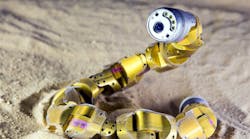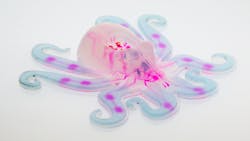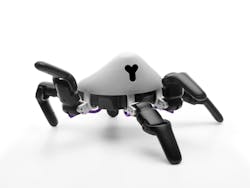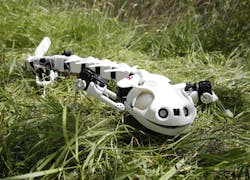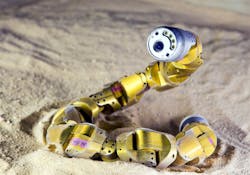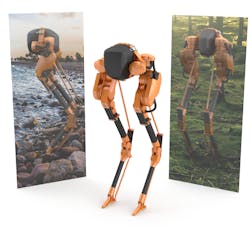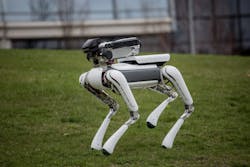The rise of robots in automation has led to many humanoid helpers. This can be best seen in collaborative robots (cobots) like Baxter from Rethink Robotics or the UR cobots from Universal Robots. The robotic arm is the new standard in automation assistance because we do not have to change the human environment for these robots to operate effectively. These human-like functioning robots can pick up, locate and place, and operate handheld machinery.
However, the human form is not the most efficient form for a robot to mirror. Sangbae Kim, leader of bio-robotics and professor at Massachusetts Institute of Technology, says that industrial robots are “designed to perform rigid and accurate position-control tasks in a fixed location…[however] manufacturing robots are not designed to control force in dynamic situations.” The goal of bio-robotics is to design a machine that can interact with its environment and dynamic situations like coming in contact with the ground. Kim points out that “when it comes to the mobile robot, the design paradigm must be completely different from industry robots.” Several companies and research groups have focused on biology-inspired robots to create more responsive machines that have an easier time manipulating their environment.
The Octobot from Harvard University
The Octobot excels in two distinct ways. First, it is a soft robot, replacing all mechanical components with analogous soft systems, and second, it’s autonomous. The robot is 3D printed, inlaid with channels for power and movement control, and the movement is powered through pneumatic controls by gas from hydrogen peroxide, which also is the liquid fuel for the robot. A circuit, a soft analog of a simple electronic oscillator, controls when hydrogen peroxide decomposes to gas to inflate the robot. The gas pushes through the limbs and the microfluidic network shuts off corresponding limbs based on external feedback. As one limb starts to deflate, the gas is redirected to another so that the robot can move. The research was headed by Robert Wood and Jennifer Lewis of the Wyss Institute for Biologically Inspired Engineering at Harvard University. Wood states that the “research demonstrates that we can easily manufacture the key components of a simple, entirely soft robot, which lays the foundation for more complex designs.”
Hexa: The Six-Legged Robot
Hexa from Vincross is a new six-legged robot that allows users to control it from their smartphone. The robot uses a variety of sensors to determine its orientation and navigate around terrain. It has the ability to scale steps and balance on uneven ground without having the need to control each individual leg. The six-legged design allows the robot to save energy by having better balance capability. According to Andy Xu, COO of Vincross, the robot “only needs three legs to stand on the ground, and we can use the other three legs to maintain balance or climb stairs.” The sensors in the Hexa bot are a digital camera with night vision, a 3-axis accelerometer, distance-measuring sensor, and an infrared transmitter. The programming language for the robot is open-source, allowing multiple users to experiment with the robot and fostering a programming marketplace. Vincross hopes to launch the robot for multiple uses as the user community grows, including exploration of dangerous situations like collapsed buildings.
Pleurobot: The Robo-Salamander
At the École Polytechnique Fédérale de Lausanne, engineers have designed a robot that mimics the motion of a salamander. The robot imitates the ambulation of the salamander with a unique vertebrate that allows the robot to slither in and out of the water. A salamander in nature can shift from a crawl to a walk to a swim by performing the same motion at different speeds. This appealed to the engineers because one doesn’t need to create different mechanisms to achieve different movements, but rather find the optimal mechanism that can perform several movements. The skeleton of the Pleurobot has only 11 spinal segments, down from the original 40 planned segments, which were not critical for the bot’s movement. The joints also have reduced freedom of movement. Auke Ijspeert, leader of the project, explains that understanding the neuro-prosthetics of the salamander is important for understanding the human spinal cord and brain interaction. “Being able to re-stimulate those circuits in humans in the long term is something very important,” he says, “and for that you need to understand how the spinal cord works.”
The Snakebot
Researchers at Carnegie Mellon University have been programming snake robots for years to get them to crawl through rubble and around obstacles. The inspiration of these robots came from observing sidewinders. Their motion can best be described in two terms: vertical and horizontal body waves. Changing the phase and amplitude of these waves allows snakes to achieve enhanced movement. The modular snake robot shown above was designed to pass horizontal and vertical waves in a 3D space. The robot is 2 inches in diameter and 37 inches long, consisting of 16 joints. Each joint is perpendicular to the previous one, allowing it to achieve numerous configurations and a variety of gaits. NASA is also using these snake robots for space exploration possibilities.
Cassie the Bipedal Bot
From Agility Robotics, Cassie is bipedal robot based specifically on the anatomy of ostriches. Cassie has three degrees of freedom at its hips and ankles, and knees that flex in one direction. The manner of walking comes very naturally to the robot due to its design, which also results in a steering mechanism that is similar to humans. The robot is lightweight and is designed to absorb shock just as humans do when they walk. The human-like movements let the robot traverse areas that humans can and its slip- and stumble-resistant feet help provide stability on uneven ground. Cassie’s possible jobs can range from delivering products to your door to search-and-rescue efforts.
Spot Mini from Boston Dynamics
Of course when discussing bio-robotics, Boston Dynamics will always come up in the conversation as one of the leaders of bio-robot design. Makers of possibly some of the best-known bio-robots like the Wildcat and Atlas, one of their latest inventions may have a future place in your home and office. The Spot Mini is a small four-legged robot that weighs 30 kilograms (including a robotic arm) and is completely electric, having a power range of 90 minutes on a single charge. The robot can pick up and handle objects using its 5 degree of freedom arm and is equipped with a sensor suit that includes stereo cameras, depth cameras, an inertial measurement unit, and position/force sensors in the limbs. The robot is small and quiet enough to be used in your office and home and has the ability to run autonomous tasks.
Festo’s Bionic Cobot
Festo, a leader in bio-inspired robotics, has designed robots that mimic kangaroo movements, swim like whales, fly like butterflies, and grip like an octopus. Their latest bio-robot mimics the human arm. The Bionic Cobot uses pneumatic lightweight drives to move and operate the arm. It has three pivoting axes and four modified rotary axes based on the DRVS semi-rotary vane drive. The robot has seven full degrees of freedom, a net weight of six kilograms, and a payload of 1.5 kg. The design uses the same human muscle principle of agonist-antagonist motion for its unique drive concept. It moves just as a bicep would flex by only tensing the upper arm muscles instead of the lower muscles. By using pneumatic pressure sensors, the arm detects any counter movement or collision to enter a safe operation mode that can be easily manipulated by the operator.
